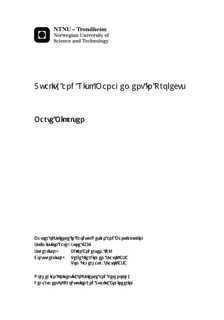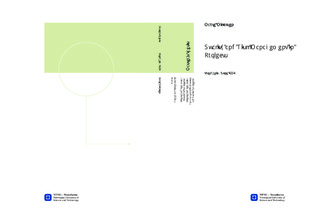| dc.description.abstract | This master thesis main topic is Quality and risk management in projects. It is written in close collaboration with the Quality and Risk Management (QRM) department at Statoil ASA (Statoil), department unit Stjørdal. The main purpose of this master thesis is to make some suggestion to a real case problem that the QRM managers struggle with on a daily basis.
Statoil is an international energy company with more than 40 years of experience from the oil and gas production on the Norwegian continental shelf. Many projects in Statoil are investment projects, moreover big and complex projects are handled by Statoil?s Project department (PRO). One of the roles in the PRO is the QRM manager. The QRM managers responsibilities is to provide an objective view on projects quality and risk management processes, by providing support for risk analysis and decision making in the investment projects. The role was introduced to Statoil after the StatoilHydro ASA (StatoilHydro) merge in November 2007.
This thesis consist of six parts, namely literature review, method, organisation study of Statoil, the QRM role in practise, strengths of the QRM model and areas of improvement.
In the literature search the following themes where studied; quality management (QM), risk management (RM) and quality and risk management (QRM). In the section about quality management ? management for quality, including relevant tools were discussed. Furthermore, process orientation to quality management and planning for quality were discussed. The quality section ends with a section on lean. Through this section the implementation of several of the tools and quality philosophies have been introduced to project management and the benefit of these tools and philosophies are discussed. The overall trend is that many of the ideas from quality management can be advantageously adapted into project management, such as lean philosophy.
In the next section some of the risk management techniques used in Statoil are presented. Moreover the different types of risks, principles for reducing these and ways of interpretation are addressed. In addition some tools for establishing a risk picture in a project, namely risk indicators, the information processing perspective and the decision making perspective, is discussed. This section concludes that risk analyses provides a good foundation for the decision makers.
The QRM literature section aim to identify areas where RM and QM can learn from each other. The areas where RM can learn from QM is identified to be the following three 1) Being able to differentiate between which risks can be handled with a statistical approach and which cannot 2)To focus on key processes and 3) Implementation of both organisational and cultural changes. The section also address how QM can learn to prioritise their work through a risk analyses and identification of likelihood and consequence of risk. By having a risk based approach to QM the allocation of recourses can be optimised.
The method chapter set the structure of the data collection of this thesis. Based on a review of governing documents and relevant literature, informal and formal interviews, personal experiences and observations ? the strengths and weaknesses of the current QRM model is identified.
The following chapter is a study of Statoil?s management system and governing documentation relevant to the QRM role. The focus is on establishing an understanding of what is expected deliverables from the QRM manager to the project development process in Statoil. In addition the different phases of the project development process is examined. The chapter have a focus on deliverables according to the RM discipline and the QM discipline. The deliverables to the QM discipline is put into the quality cycle consisting of quality planning, quality assurance, quality control and quality improvement.
Statoil operations are global, consequently the level of uncertainty is bigger compared to having operations in only one nation. There is a growing focus on risk management in industry, a trend that Statoil also have noticed. The requirement of risk analysis from top management justifies the need for a QRM manager in projects.
The strengths of the existing QRM model is identified as it is presented in the list below.
? Courageous QRM managers will challenge the system into continuous improvement
? Good organisation of resources based on risk analysis
? Being a generalist is an advantage in facilitating risk workshops
? The QRM managers poses the ability to communicate with different levels of the organisation
? Good system understanding through being auditor certified
? Facilitation of risk workshops and use of risk analysis
? Take advantage of the relationship between risk- and quality management
? The role is integrated into several levels of the organisation
? Statoil?s focus on risk management is in line with the QRM role
Since this model have not been in the Statoil system more than five years, there are still some areas of improvement in order to fully integrate the risk based approach to quality management in the organisation. Not only are the weaknesses of the existing QRM model identified, but also some suggestions based on literature, personal experience and discussions with the interviewees are presented.
The easiest areas of improvement identified in this thesis is better training of juniors, actions to reducing the turnover rate of QRM managers, improving quality control of the QRM managers work, more quality focus through a more cycle view on quality in the department, and at last getting the missing experiences through studies of investigation reports from the Petroleum Safety Authority Norway (Ptil).
The more challenging actions that should be focused on in order to get a more homogenous and less ambiguous mandate to the QRM role. The QRM department should focus on adapting to a set of terminology equal to the rest of the world, closer follow-up on mitigating and focus on getting the right people to participate in risk workshops in order to identify the right risk.
The findings from this thesis indicates that elements and ideas from the QRM model can be generalised and successfully implemented by other organisations. The main imitating factor of this thesis is time and experience with project execution from the author. | |

